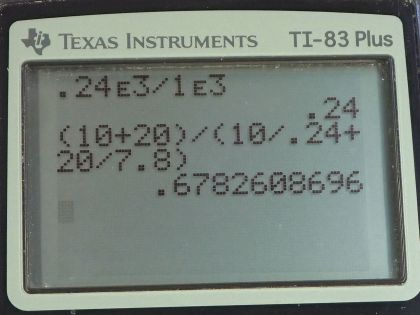Question
A simple compass can be made by placing a small bar magnet on a cork floating in water. (a) What fraction of a plain cork will be submerged when floating in water? (b) If the cork has a mass of 10.0 g and a 20.0-g magnet is placed on it, what fraction of the cork will be submerged? (c) Will the bar magnet and cork float in ethyl alcohol?
Final Answer
- Yes, the cork with magnet will float in ethyl alcohol since the average density of the cork-magnet combination is less than that of ethyl alcohol.
Solution video
OpenStax College Physics for AP® Courses, Chapter 11, Problem 48 (Problems & Exercises)

vote with a rating of
votes with an average rating of
.
Calculator Screenshots
Video Transcript
This is College Physics Answers with Shaun Dychko. A simple compass is going to be made by putting a piece of cork in water and then put a magnet on top of that cork but in part (a), before the magnet's involved, we are just curious about what the fraction submerged of just the cork is and so that's going to be the density of cork divided by the density of water. We look up the density of cork in our table [11.1]— and that's here 0.24 times 10 to the 3 kilograms per cubic meter— and so we divide that by the density of water which is 1.000 times 10 to the 3 and that is 0.24 so only 24 percent of the cork is submerged. In part (b), we want to know the fraction submerged when we place a magnet on top of it. So we have 10 grams worth of cork and then we have on top of it, 20.0 grams of a magnet and we have to assume there's a certain material for the magnet; it could be nickel or some other magnetic material but typically it's iron so we are gonna make an assumption that they are referring to iron here and there's 20.0 grams of iron. So the fraction submerged will be the average density of this cork-iron combination divided by the density of water and so the average density of the cork and iron will be the total mass of cork and iron divided by the total volume of cork and iron. So we are given the masses— that part is straightforward— but these volume's we'll have to think about a little bit. So density of cork is mass of cork divided by volume of cork and we can rearrange this to solve for volume by multiplying both sides by V cork divided by ρ cork and that gives us that the volume of cork then is the mass of the cork divided by its density. And the same process applies to the volume of iron: it's gonna be the mass of the iron divided by the density of iron. So we make substitutions using each of these in place of the volume's in our average density formula and we do that here. So let's calculate what this average density is. So that's 10.0 grams of cork plus 20.0 grams of iron divided by 10.0 grams of cork divided by its density and we are using grams per milliliter here just because it's less writing to do that and it also goes well with the grams that we have in our numerator; we could have converted this numerator into kilograms but then that'd be more writing. Okay! So cork has a density of 0.24 grams per milliliter and then add to that 20.0 grams of iron divided by iron's density, 7.8 grams per milliliter, as it shows here and all this equals 0.67826 grams per milliliter. So the fraction submerged then is that average density that we just calculated divided by the density of water, which is 1.000, and we get 0.68 so 68 percent of this compass is submerged. Part (c) asks will this float in ethyl alcohol and the answer is yes because the average density of this compass, 0.68, is less than the density of ethyl alcohol, which is 0.79.
